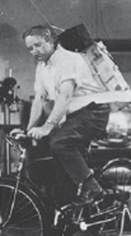In 1949, the American biophysicist Norman Jefferis Holter (1914-1983) invented the portable electrocardiograph which bears his name today. Holter received a master's degree in chemistry and physics and had the opportunity to study nerve conduction tests with Dr. Joseph Gengerelli. During World War II, he worked as a physicist for the marines, and after the war he led a group of oceanographic engineers in the atomic tests at Bikini Atoll. Upon returning home, he successfully recorded the electroencephalographic information of a young man riding a bicycle, and then decided to move the electrodes from the head to the chest, giving rise to the era of cardiac telemetry. After successive technological improvements of his invention, he was able to develop the first truly portable cardiac telemetry device, and sold the patent to Del Mar Avionics, an aeronautical company which manufactured the device for 40 years. Subsequently, Holter donated the rights to his invention to medicine. The first reported clinical use of the ambulatory electrocardiograph occurred in 1954 and was published in the Canadian Medical Association Journal. Since then, its uses and applications have evolved continually.
Holter ECG: an ambulatory electrocardiographic recording using a portable recorder with two or three precordial leads which runs continuously for 24 or 48 hours, or intermittently over longer periods of time. An analysis of the data shows the circadian variability of the heart rate, episodes of bradyarrhythmia, tachyarrhythmia or atrioventricular block, abnormal QRS complexes -extrasystoles or bundle branch blocks- and transient repolarization or QT interval disorders.
Although the term Holter blood pressure monitoring is widespread and accepted by some groups, the Medical Terms Dictionary advises against its use, since this diagnostic method was derived from a different source, which did not involve this notable scientist, and was developed under the name ambulatory blood pressure monitoring.











 texto em
texto em 



